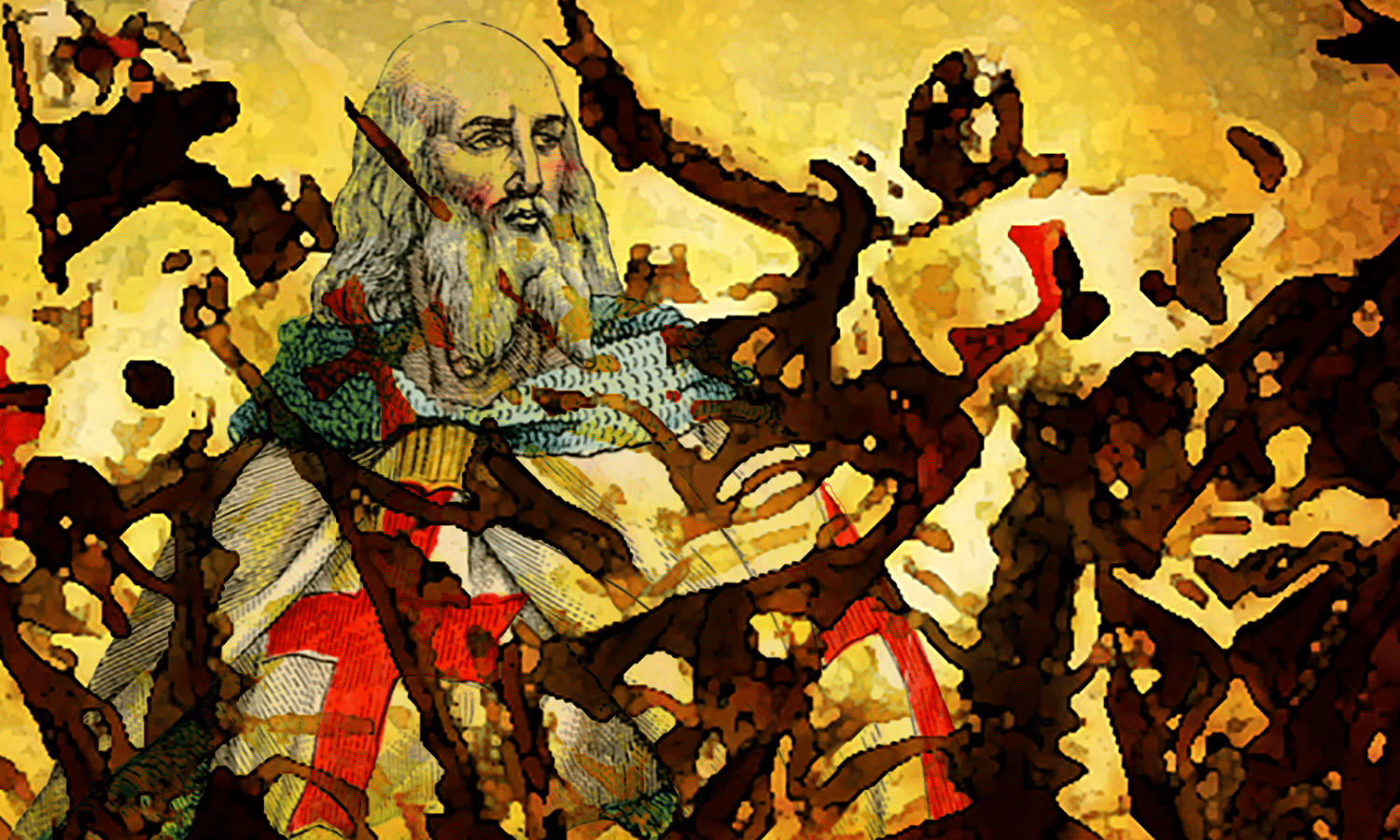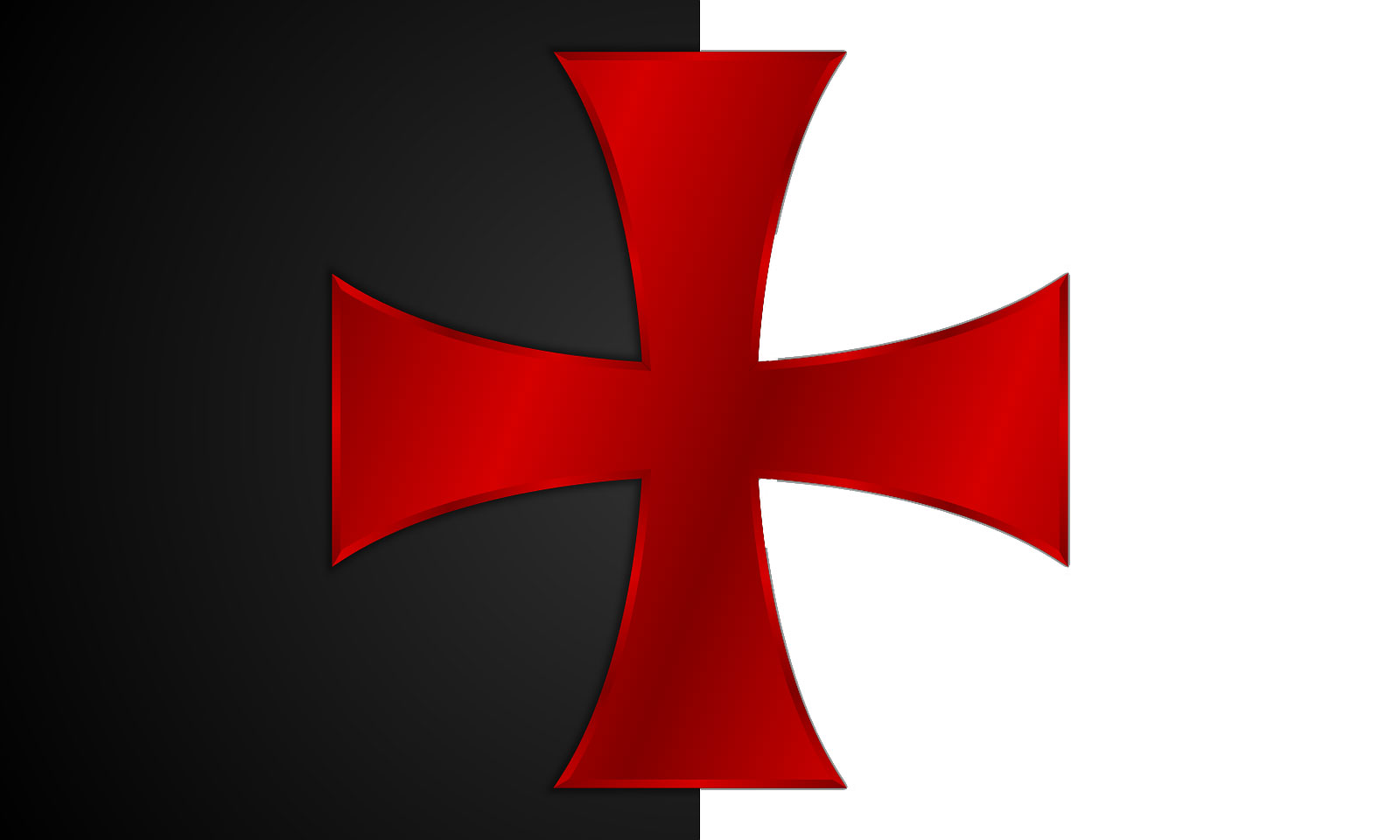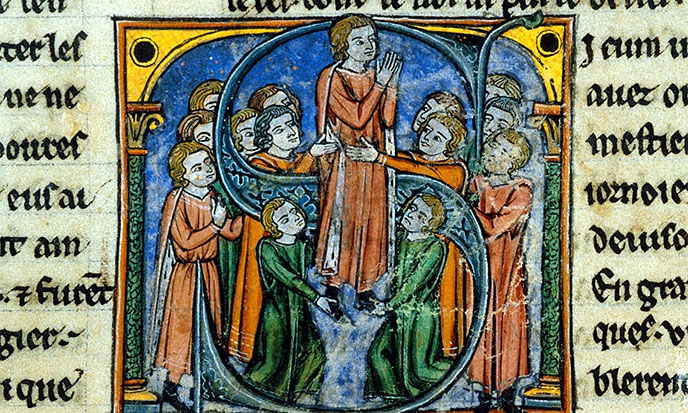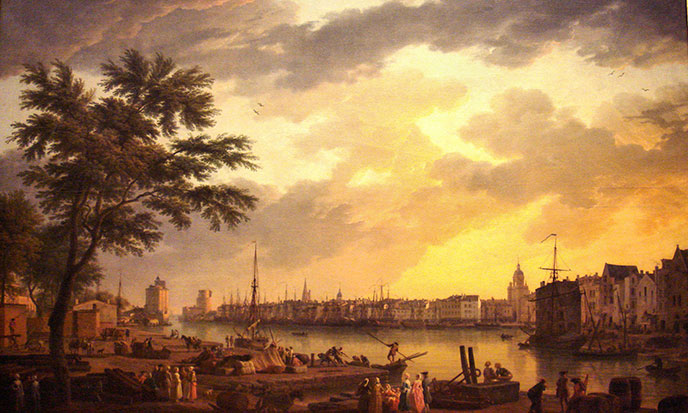
A thousand years ago, pilgrims were flocking in numbers on the roads and paths of Europe. The great fear of the Year Thousand had boosted their devotion. They went to Compostela, Rome, and especially to the Holy Land.
The Eastern Roads being unsafe, pilgrims were constantly spoiled or killed by the Moors. This is why, from 1095 AD, the pope preached the First Crusade. Urban II asked the Christians from the West to take up arms to rescue the Christians from the East.
Non nobis, domine, non nobis sed nomini tuo da gloriam ——– Not for us, Lord, not for us but for the glory of your name. (Templars’ Motto)
God’s Will
At the cry of “God will!”, all those who took part in the crusade were marked by the sign of the cross, becoming the Crusaders. On July 15th 1099, under the leadership of Godfrey of Bouillon, the Christian troops took Jerusalem. Acclaimed by his peers as the king of Jerusalem, Godfrey of Bouillon took possession of the Holy Sepulcher. Some armed men then began serving the patriarch to ensure his security. Soon the need was felt for an armed militia that would protect the pilgrims.
Thus was born the army of Christ, the first version of the Knights Templars. They set up their headquarters in the buildings of the Temple of Solomon in Jerusalem. Around Hugh Payens, the militia gathered seven valiant knights who were named Geoffrey de Saint-Omer, André de Montbard, Payen Montdidier, Geoffroy Brisol Frameries, Rolland de Provence, Saint-Amand Archambault and the mysterious Gondemare. Thanks to the help of Moorish contacts, Gondemare made an astonishing discovery.
Solomon’s Secret
A scholar of his friends gave him a bundle of papyrus texts which were written in Coptic and in Greek. In this time, noble people spoke Latin and read Greek fluently. The Knights did not escape this rule. Certainly, the ancient calligraphy discouraged them a bit, but the text was too exciting. They deciphered with passion travel books about forgotten maritime roads, to a distant continent where gold, silver and gems were harvested in abundance. And came for them the time of Dream.
Coupled with the scrolls, they unfolded a sheepskin in which was painted a maritime map. The Atlantic Ocean showed its two shores, the road Alizées was well indicated, dotted with wind roses at the changes of course. On the opposite mainland, you could see the locations of mines of silver and gems. The Knights had read Plato’s fascinating dialogues, Timaeus and Critias. The land of plenty, would it be the philosopher’s Atlantis? The Knights were not interested in wealth.

They were secretly fascinated by the adventure and excitement of the discovery for the glory of Christ. For now, they had other emergencies. Their Order being insufficient in number, they needed to transform their militia into a religious order. Bernard of Clairvaux, the future Saint-Bernard, pleaded their cause with the Pope, who took the Knights under his direct protection. In 1129, the Council of Troyes endorsed the creation of a congregation anti-charity and surreal: the Knights Monks.
As the monks of ShaoLin, the Poor Knights of Christ and of the Temple of Solomon were kings of fighting. These gutters of Moors mandated by the Pope hacked into pieces in the day, dressed the wounds in the evening, and at night prayed for the salvation of the souls of their victims. Good heaven, in the holy name of God, there is something messing a lot in there. Here is where it leads to claim to be God of Love while you are Sabaoth, God of Armies…
Jesus Christ! What is there in common between his message of love and these mercenaries who sever and who cut? We remember the saying of Jesus on those who use the sword. We remember his rejection of the political thing: “Render unto Caesar what is Caesar’s and unto God what is God’s.” It is true that the Popes’ luxury is the opposite of the asceticism of Jesus who had not even a stone to lay his head. But still… there is something fishy. Militia of the Pope, the Knights Templar ensure first the Roman peace.
Do they work for Jesus or for Rome?
The Templars are a Christian order of knights-monks directly depending on the pope — ie on the emperor of Rome. They represent the Roman power in western Europe and were even entitled to tax people. Quickly the order of the Temple became the first fortune and the first power in Europe.
The Knights of the Temple also served as escort and tour operators for pilgrims, becoming the first Club Med counselors in French history. They could be recognized from a distance thanks to their white coats adorned with the red flared cross. When the pilgrims saw dust arise from the familiar faces, they knew they were saved. Soon the Templars owned a fleet of merchant ships that served both to transport pilgrims and goods. All along the land or sea road, Templars were everywhere.
They Invented Modern Banking
At every stop was a Templar Preceptory, ensuring the safety of pilgrims, providing food and shelter, and even, if necessary, replenishing their purses in coin of the realm. As the Templars were established throughout Europe, each pilgrim, before leaving, took care to get to the nearest Preceptory, to pour a certain amount of money to receive in exchange a promissory note in any Western or Eastern Templar place. These “travelers cheques” rapidly knew a great success.
Sparing the risk of bringing gold, the promissory notes became very popular. On this simple idea was built the colossal empire of the Temple, and formed his famous lost treasure. So, without thinking, the Templars invented the bank! They were also builders, and on what scale! They covered Europe with a white mantle of chapels, churches, command posts, basilicas and cathedrals, that would mark forever the European landscape. Funded by money from the Temple, countless sites opened.

The Art Of Sacred Building
The 12th and 13th centuries were a genuine pre-Renaissance in the arts, craft and engineering. This bright time was called The Spring of Cathedrals. With their wallet fixed to a stick, their tools slung across the shoulder, the companions masons, carpenters or image makers , went from city to city. Each project brought together a few dozens to several thousand companions. It was one of the largest shipyards in Europe, but it was primarily a traditional school of sacred building.
For the Companions, under the influence of the spirituality of the Templars, have rediscovered over the millennia the megalithic science of the sacred building. They found again the art of building with energy, the art of channeling in stone the cosmic-telluric forces, the art of changing the glass and stone into prayers of light. To build all this, they needed more and more money. Although comfortable, their bank profits added to donations were never enough for their works, which had become too huge.
Pushed by a torrent of cash, three centuries of incredible prosperity would follow. It was a period of peace, culture and abundance for a united Europe in the peace of Christ … or that of the Emperor Constantine, i.e. the Pax Romana. As companions, students from all countries went from town to town to follow their masters, all itinerant teachers. The Sorbonne was built in Paris to serve as their residence: the Erasmus system worked perfectly a millennium ago! There were no borders in Europe. It spoke a single language, Latin, from Amsterdam to Salamanca. Diplomas were valid throughout Europe and the opportunities were not lacking.
It is no exaggeration to say that the whole Europe was under construction. Not only religious buildings, they were also building bridges, paved roads, and Commander’s and Templars’ places around which grew prosperous towns. On these roads, the Knights were the country police. They also built the ports where their fleet was expanding. One port in Normandy to serve England, three ports on the Mediterranean to serve the East. What for their most beautiful port, to which converges the largest number of Templar lanes?
How did they use the port of La Rochelle?

The Mystery Of La Rochelle
“The presence of the Templars at La Rochelle dates back to the birth of the city. From 1139 they received from Eleanor of Aquitaine watermills located at the mouth of the river of Lafond as well as land in the center of the city. This is where they established their commander, facing the port from which they were separated only by the wall of the Grand Bank.”
Later fortified by Vauban, the port did already consist of a vast basin protected, and it benefitted from the close presence of the largest shipyard at the time. The Templars had built there the largest fleet in Europe. To this maritime node, the majority of Templar wide roads converged in star from all parts of Europe. Then? Why? As its name indicates, a port is a door. To which country was thus leading this “door” of La Rochelle? As incredible as it may seem, the port of La Rochelle was the gateway to America.
Yes, four centuries before Christopher Columbus, the Poor Knights had found the road to Golconda and Eldorado, the Royal Route of the treasures of Cipango.
Using the map in sheepskin, they had reopened the transatlantic route, they had landed in America, where the natives had taken them for gods. The situation is recurrent in the history. Without shame, for the greatest glory of God, the Knights Templars have mounted mining exploitations in Mexico and in the Andes. (source)Jacques de Mahieu, The Templars in America Soon the first galleons laden with gold and gems were en route to La Rochelle.
At the head of an incalculable fortune,
the Temple became the first European power …


